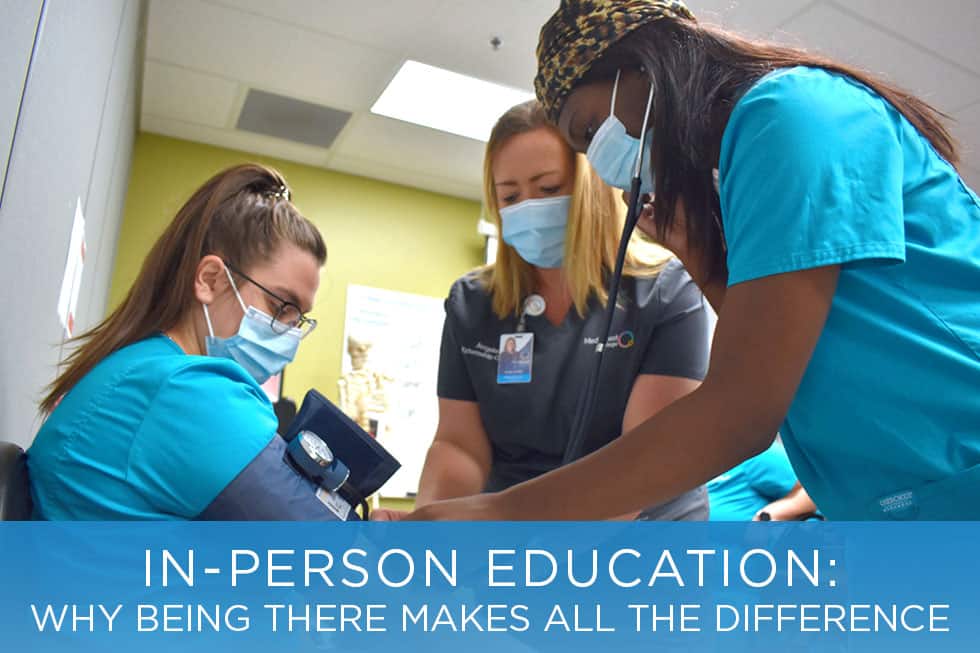There’s no question the digital technology revolution has transformed the world as we know it. However, there are some things that just aren’t the same in the virtual world, such as healthcare education. The differences between in-person and virtual education have become a topic of much debate. If you’re considering a career in healthcare, it’s important to understand those differences. Let’s break it down.
The Benefits of Face-to-Face Interaction
One of the biggest advantages of onsite education is the opportunity for face-to-face interaction with instructors and peers. In a traditional classroom setting, students have the chance to ask questions, receive immediate feedback, and engage in discussions with others. This interaction is particularly important for students who need additional help or struggle with certain concepts.
Being in the same physical space with your instructors and peers can also lead to more meaningful relationships. Students can connect with others who have similar interests and backgrounds, and these connections can ultimately lead to opportunities for collaboration and networking.
Face-to-face interaction also allows for nonverbal cues and body language, which can help build trust and strengthen relationships. This is particularly important in a field like healthcare where interpersonal skills are crucial.
Networking Opportunities
Networking is also a key advantage of in-person education. Your classmates and instructors can be valuable resources when it comes to internships, job opportunities, and professional references. Building strong relationships with those in your field can help you better navigate your career path.
Hands-On Learning Opportunities
There are some things that online learning just cannot replicate and one of those things is the hands-on learning opportunities that are available via in-person education. Things like drawing blood, recording vital signs, operating different types of equipment such as X-rays or ultrasound machines, and dental procedures are vital for healthcare professionals to learn during their training. There is no substitute for so many things that you simply must learn to do by doing them.
Hands-on learning opportunities provide a way for students to practice and apply what they’ve learned in a safe, supervised environment. It allows them to develop their skills and gain real-world experience that can be carried with them throughout their careers. Essentially, students pursuing careers in patient care of any kind benefit from the ability to engage with real-world environments, people, and resources in ways that are simply not possible in an online setting.
Access to Resources and Facilities
Another advantage of onsite education is the immediate access to resources and facilities that online education doesn’t provide. Students who attend a physical school have access to technology, libraries, laboratories, and equipment. These resources can be expensive and difficult to access online, especially for those who don’t have access to a computer or the internet at home.
Physical schools also provide students with a safe and conducive environment to learn and study. Onsite schools offer a range of facilities that can cater to a variety of learning needs. In contrast, online students may be limited to virtual resources and textbooks, which may not offer the same depth and breadth of knowledge.
Immediate Feedback and Personalized Attention
In a traditional classroom setting, instructors can observe and assess students’ understanding of the material in real-time. This allows them to address any misconceptions in knowledge immediately, ensuring that students can fully grasp the content being taught.
Students also have the opportunity to ask questions and seek clarification on specific topics, tailoring their learning experience to their individual needs. Instructors can provide targeted guidance and support by adapting their teaching methods to suit each student’s learning style. This level of personalization is invaluable in helping students overcome challenges and reach their full potential.
Online learning has its place in education and even in healthcare, some courses that don’t require hands-on training can still be effective in an online format. However, for so much of what is required for many healthcare career paths, there’s just no substitute for being there.
If you’re interested in learning more about careers in healthcare, check out the programs at MedQuest College. MedQuest is helping students get the hands-on training and skills they need to launch new careers in healthcare. Contact us today to learn more.

